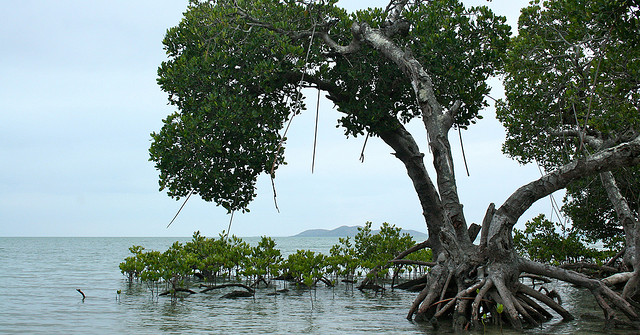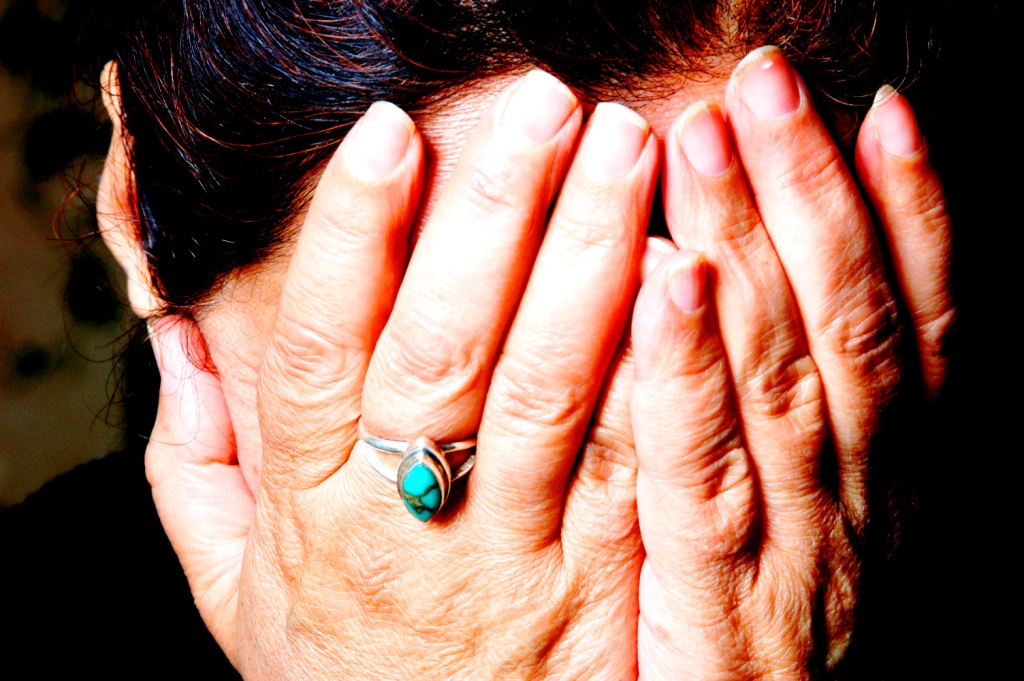Have you ever seen a mangrove swamp?
Mangrove swamps, which sit in tropical and subtropical coastal areas, are wetlands comprised of a unique type of tree with large, branch-like roots that plunge down into the dirt and sand. When the tides change or waves come ashore, their dense root systems act as a web that prevents the ground from eroding and washing away.
The mangrove trees protect the sensitive ecosystem from damage, and make it easier for the ecosystem to recover, even after storms and tidal waves.
What does this have to do with resilience?
If you think about it, we are all subject to (metaphorical) changing tides, storms, and tidal waves.
Our circumstances get better, then worse, then better again. Or just when everything seems to be going great, we get sick, or lose money, or lose a relationship. And every once in a while, we experience a truly catastrophic experience that threatens to wash our entire beach away.
A resilient mind, though, is like the mangrove swamp. It has deep roots that protect it from the insults and stress inherent in daily life. When bad things happen, the resilient mind bounces back. The resilient mind can recover from, and find meaning in, even the most painful and difficult experiences.
A story of resilience
Anthony, a young man I treated for Post-Traumatic Stress Disorder (PTSD) at the VA Hospital, was only 22 when he enlisted in the Army in 2005. He was soon deployed to a combat zone in Afghanistan.
When he returned a few years later, he was a shell of his former self. His marriage had unraveled, and he was estranged from his 5-year old daughter. He had developed the habit of constantly looking over his shoulder and worrying about his surroundings. Even though he dreamt of going back to school, he was too terrified to set foot on a college campus. His friendly and affable exterior hid an inner well of pain and fear.
As part of his therapy, Anthony and I talked extensively about his experiences during the war. He told me about the unease and anxiety of being constantly unsafe. He told me about the multiple times he was almost killed. He told me about the time he held his friend in his arms as he bled to death after being struck through the chest with shrapnel.
Don’t worry—the story ends well for Anthony. But before I tell you more about him, I want to talk a little bit more about resilience.
What makes a person resilient?
What is the difference between someone who is resilient and someone who is not? What factors make it possible for some people to bounce back from stressful experiences?
Studies suggest that there are several features of resilience:
- An ability to face fears by overcoming them, thereby increasing self-esteem.
- Optimism and a positive attitude.
- Cognitive flexibility, or the ability to assimilate negative experiences, accept them, and reframe them into something positive.
- A strong moral compass and core belief system.
- A recognition of one’s inner strengths and attention toward cultivating them.
- Attention toward nurturing a strong social support network.
Fortunately, resilience is not just something you are born with, but something you can develop.
Cultivating your mangrove swamp
When Anthony and I worked together, we spent a lot of time talking about his experience in the war as a way to habituate him to his fear (a primary component of therapy for PTSD is exposure). But, talking about the experience was not enough.
With practice, Anthony was quickly able to do things he had avoided for years, such as going to grocery stores at rush hour and sitting in crowded movie theatres. He even signed up for classes at a local community college.
However, he was still overcome with guilt that he had survived when many of his closest friends had not. He felt unsure about his future and what he wanted to do with his life. He needed help reframing his experience into something positive. He needed help understanding what had happened and finding meaning in it.
The Automatic Thought Log exercise
The work of strengthening roots in your own mangrove swamp comes with challenging negative thought patterns, over and over again. You build your ability to reframe experiences like a muscle—with practice.
With Anthony, I used a specific exercise to help him reframe his experience, called the Automatic Thought Log.
First, I had him write down a distressing, negative thought or assumption. He chose, “It’s my fault my friends died—I didn’t do enough to help them.” Then, I asked him what percentage of him believed this was true. He said,“90%”
Next, I asked him to tell me all the evidence that it was true. He gave examples like, “My partner died and it was my job to protect him” and “I didn’t call the medic fast enough.”
Then, I asked Anthony to tell me all the evidence that his assumption wasn’t true. I asked him specifically to imagine he could talk to his good friend who had been killed in front of him. What would his friend say? Would his friend blame him for not saving him?
In this moment, a light bulb went off for Anthony. He realized right away that no, his friend wouldn’t blame him, and more than that, he would want Anthony to move on with his life and find happiness as a way to honor him.
After the exercise, I asked Anthony what percentage of him still believed his assumption was true, and he answered, “40%.” It wasn’t zero, but he was moving in the right direction. I could see a thicket of mangrove roots plunging into Anthony’s swamp right in front of me.
Over the next few months, Anthony continued to work hard to process many difficult emotions, including his fear, his guilt, his grief, and his regret. As he did, his life transformed.
He started school with a fierce resolve: He would graduate college and then apply to a social work program so he could work with young veterans just like him, and help them reacclimate to home after returning from war. He had found a new purpose. He had found meaning in a terrible experience.
If Anthony can do it, so can you. What could you do to help cultivate your own mangrove swamp?
Photo by Vincent Chaigneau






Thanks for sharing this experience Elana. Way to go Anthony! The exercise you did with Anthony seems interesting. Anthony was also willing to accept your help and I truly believe that’s important in this process. There will always be change in our lives and knowing how to adapt to those situations is important in enhancing our resilience.
What a fantastic story. Thank you for sharing us.
Anthony is a very strong and resourceful person as are you.
I face my own version of PTSD each day.
Anthony’s story of exposure and response prevention is truly inspiring!
Elana, thank you for sharing this story and most importantly the work you are doing to help others navigate change.
I too have found building my own mangrove swamp and that of my coaching clients very invaluable.
Since we can’t choose what life throws at us, we can at least find relief and firm grounding in the roots of our mangroves. It does take some work but it pays off.
– Jazilah
Thanks for this inspiring post. I love the automatic thought log exercise. I use a version of this to combat negative thinking in myself. I try to look at the “evidence” in a situation instead of relying on my personal perceptions, which are often clouded by my perfectionist tendencies. And to try to cultivate more compassion for myself, I think how my friends would react to my situation. They would undoubtedly support me fully with love and compassion (and I realize I would do the same for them in a similar circumstance).
Hi Elaina,
Aside from how moving the actual story was, I don’t entirely think the “mangrove swamp” is a metaphor. I think we are extension of the natural world in which we live. The mangrove is a complex defense mechanism, just like we have defenses of our own…some of which “kick the can down the road” and amplify the problems later.
I love how you were able to move Anthony out of his ego state and allow him to gain a broader perspective. Thank you for an excellent piece.
Beautifully written post. Your suggestion to develop mangrove roots to withstand vicissitudes of life , which every one is prone to in less or more degrees, is brilliant. Thanks for bringing up this inspiring post.
Thanks Elana
A really inspiring story. I am going through a difficult divorce. I had thought my husband and I could do it with dignity but I was wrong…I so wanted to divorce with dignity and be honourable but he wont allow it. However, I am determined no resolved to be dignified in my behaviour and when the going gets tough to honour the light within me and my core values and beliefs.
So I intend to create a booklet with tips and resources to help others going through this minefield of divorce. Ways of releasing emotions without taking it out on their partner and practical advice.
Thanks again.,..as the saying goes Every cloud has a silver lining. For every low there is a high, that’s how the universe works.
Sharon
I think a lot of people don’t realize the value of strong personal network in dealing with adversity and building resilience until it is too late. Many of the institutions (school/university) that are involved in shaping/influencing people outlook on life, often only pay lip service to the value of a network and don’t view it as important as things like academic achievement, even though the importance of academic achievement is short lived compared with the impact of your social network.
Elana,
Thanks for sharing a great story, and a wonderful analogy. I have never thought of resilience as being similar to a mangrove swamp, but it is a such a good parallel.
Dealing with adversity can be tough, and it is something that we all have to deal with at some point and time. Strengthening resilience to deal with these traumatic moments is key and your example of how you helped Anthony is something that we can all take, modify and use for ourselves.
SJ
I like the analogy of the mangrove trees. I think in general it’s good to look at nature to find strength. A tree grows roots first before it grows in height, and when it does it blossoms with flowers that add to the beauty of the world. For that matter I think it’s also important for us to grow our roots; to be rooted in the body; to be present in the here and now. Only then can we truly start living, giving, receiving, and perceiving whatever comes to us as a blessing.